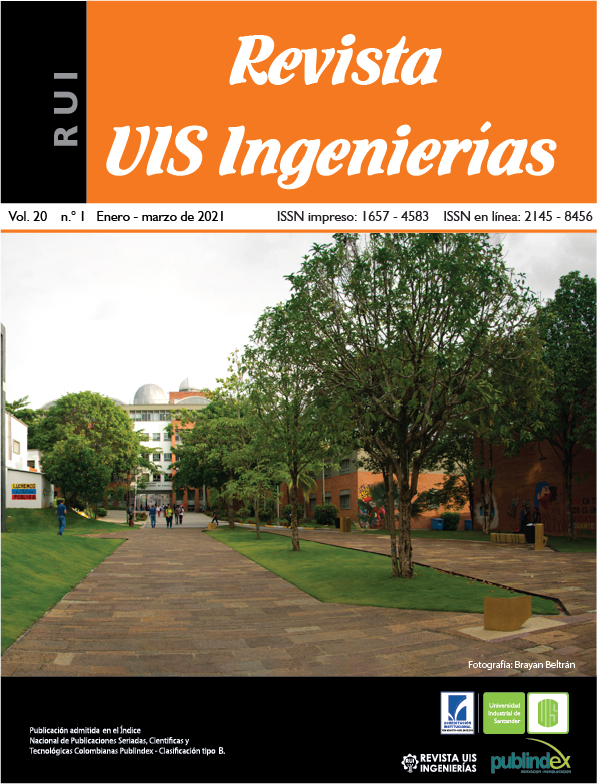Publicado 2020-11-19
Palabras clave
- BFR,
- descargas atmosféricas,
- ATPDraw,
- tasa de fallas,
- sistemas de puesta a tierra
- IEEE 1243,
- líneas de transmisión ...Más
Cómo citar
Derechos de autor 2020 Revista UIS Ingenierías

Esta obra está bajo una licencia internacional Creative Commons Atribución-SinDerivadas 4.0.
Resumen
Este trabajo trata sobre los dos diferentes modelos resistivos de puesta a tierra usados en líneas de transmisión presentados en el estándar IEEE 1243-1997: tierra suplementaria con varillas y con contrapesos. Se analizó el efecto de variar los parámetros internos de cada modelo que afectan el valor resistivo de puesta a tierra en la reducción o aumento de la tasa de fallas por flameo inverso por impactos de rayos sobre la torre o el cable de guarda sobre terrenos con diferentes conductividades. El software ATPDraw se usó para obtener las corrientes críticas, para luego con estas obtener la tasa de fallas de la línea. Se simuló el efecto del número, la longitud, radio y enterramiento de los electrodos en las tasas de fallas por flameo inverso de una línea de transmisión para diferentes valores de conductividad del terreno. Se obtuvieron porcentajes de reducción de la tasa de fallas que van en general desde el 50 hasta el 95%.
Descargas
Referencias
[2] H. Torres, “El espacio y el tiempo en los parámetros del rayo”, en El rayo. Mitos, leyendas, ciencia y tecnología, 2ª ed., Bogotá, Colombia: UNIBIBLOS, 2002, pp. 123-131.
[3] CIGRE Working Group of Lightning, Guide to the procedures for estimating the lightning performance of transmission lines. CIGRE, Paris, Francia, 1991.
[4] A.R. Hileman, Insulation coordination for power systems. Boca Raton, FL, USA: CRC Press, 1999.
[5] F. Casas, Tierras: soporte de la Seguridad Eléctrica, 3ª ed. Bogotá, Colombia: ICONTEC, 2006.
[6] F.M. Gatta, A. Geri, S. Lauria, M. Maccioni, “Backflashover simulation of HV transmission lines with enhanced counterpoise groundings”, Electric Power System Research, vol. 79, no. 7, pp. 1076-1084, 2009, doi: 10.1016/j.epsr.2009.01.008
[7] W. A. Chisholm, W. Janischewskyj, “Lightning surge response of ground electrodes”, IEEE Transactions on Power Delivery, vol. 9, no. 4, pp. 95-95, 1989, doi: 10.1109/MPER.1989.4310635
[8] “Guide for Improving the Lightning Performance of Transmission Lines”, en IEEE Std 1243-1997, pp.1-44, 16 dec. 1997, doi: 10.1109/IEEESTD.1997.84660
[9] IEEE working group report, “Estimating lightning performance of transmission lines II – Updates to analytical models”, IEEE Transactions on Power Delivery, vol.8, no.3, pp. 1254-1267, 1993.
[10] J. A. Martinez, F. Castro-Aranda, “Lightning performance of transmission lines using the EMTP”, en IEEE Power engineering society general meeting (IEEE Cat. No 03CH37491), Toronto, Ontario, Canadá, 2003, pp. 295-300, doi: 10.1109 / PES.2003.1267186
[11] I. M. Dudurych, T. J. Gallagher, J. Corbett, M. V. Escudero, “EMTP analysis of the lightning performance of a HV transmission line”, en IEE Proceedings - Generation, Transmission and Distribution, vol. 150, no. 4, pp. 501-506, 2003, doi: 10.1049/ip-gtd:20030252
[12] M. Z. A. Ab. Kadir, I. Cotton, “Implementation of the modified leader progression model in backflashover analysis”, en IEEE International Power and Energy Conference, Putra Jaya, Malasia, 2006, pp. 516-521, doi: 10.1109 / PECON.2006.346706
[13] H. Swalehe, P. V. Chombo, B. Marungsri, “Flashover and back-flashover analysis with lightning strokes of 69 kV and 24 kV lines in Thailand using ATP/EMTP”, International Journal of Energy Conversion., vol. 6, no. 4, pp. 111-120, 2018.
[14] M. A. Abd-Allah, T. Elyan, “Analysis for Egyptian 500kV and 220kV Transmission towers”, International Journal of Scientific and Research Publications, vol. 6, no. 4, pp. 289-297, 2016.
[15] I. L. Avila, G.F. di Mauro, J. A. Suárez, “Estudio de los efectos de las descargas atmosféricas sobre la confiabilidad de las líneas aéreas de transporte de energía”, en III Congreso De las Américas de Distribución Eléctrica, Ciudad de Córdoba, Argentina, 2016.
[16] A. Halim, A. Bakar, H. Mokhlis, S. A. Halim, S. Sarah, M. Isa, H. A. Illias, “Analysis of Arrester Energy for 132kV Overhead Transmission Line due to Back Flashover and Shielding Failure”, en IEEE International Conference on Power and Energy (PECon), Kota Kinabalu, 2012, pp. 683-688, doi: 10.1109/PECon.2012.6450302
[17] B. Marungsri, S. Boonpoke, A. Rawangpai, A. Oonsivilai, C. Kritayakornupong, “Study of Tower Grounding Resistance Effected Back Flashover to 500 kV Transmission Line in Thailand by using ATP/EMTP”, International Journal of Electrical and Electronics Engineering, vol. 3, no. 10, pp. 617-624, 2009.
[18] F.M. Gatta, A. Geri, S. Lauria, “Backflashover simulation of HV transmission lines with concentrated tower grounding”, Electric Power System Research, vol. 73, no. 3, pp. 373-381, 2005, doi: 10.1016/j.epsr.2004.08.011
[19] F. M. Gatta, A. Geri, S. Lauria, M. Maccioni, “Backflashover simulation of HV transmission lines with enhanced counterpoise groundings”, Electric Power System Research, vol. 79, no. 7, pp. 1076-1084, 2009, doi: 10.1016/j.epsr.2009.01.008
[20] S. Visacro, F. H. Silveira, “Lightning Performance of Transmission Lines: Requirements of Tower-Footing Electrodes Consisting of Long Counterpoise Wires”, IEEE Transactions on Power Delivery, vol. 31, no. 4, pp. 1524-1532, 2016, doi: 10.1109/TPWRD.2015.2494520
[21] J. Montaña, “Recommendations for grounding systems in lightning protection systems”, Ingeniería e Investigación, vol. 31, no. 2, pp. 5-10, 2011.
[22] R. Shariatinasab, J. Gholinezhad, “The effect of grounding system modeling on lightning-related studies of transmission lines”, Journal of Applied Research Technolology, vol. 15, no. 6, pp. 545-554, 2017.
[23] M.A. Sargent, M. Darveniza, “Tower surge impedance”, IEEE Transactions On Power Apparatus and Systems, vol. 88, no. 5, pp. 680-687, 1969, doi: 10.1109 / TPAS.1969.292357
[24] H. W. Dommel, “Electromagnetic Transients Program Reference Manual. EMTP Theory Book”, en Prepared for Bonneville Power Administration, Portland, OR, USA, 1986.
[25] Ministerio de Minas y Energía, Reglamento Técnico de Instalaciones Eléctricas, 2013.
[26] M. Darveniza, F. Popolansky, E. R. Whitehead, “Lightning protection of UHV transmission lines”, Electra, no. 41, pp. 39-69, 1975.
